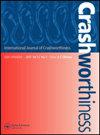An empirical analysis on the effects of alcohol-impairment in injury severities of motorcyclists
IF 2
4区 工程技术
Q3 ENGINEERING, MANUFACTURING
引用次数: 0
Abstract
AbstractThis research study examined the factors contributing to the injury severity of alcohol-impaired motorcyclists (BAC ≥ 0.08), compared to non-alcohol-impaired motorcyclists (BAC < 0.08). This study modelled rider injury severity in single-motorcycle crashes using random parameter multinomial logit with heterogeneity in mean and variance. This approach accounts for possible unobserved heterogeneity in the data resulting from rider, roadway, motorcycle, traffic and/or environmental conditions. The model results show that rider characteristics, such as role (rider), demographics (age between 50 and 65 years), motorcycle type (cruiser), rider endorsement (endorsement required), riding behaviour (speed more than 10 mph over the speed limit), riding action (no distraction prior to crashes), no helmet usage, roadway characteristics (left curved alignment, road surface condition), temporal characteristics (Sundays), spatial characteristics (Florida Department of Transportation District 5) and crash characteristics (collision with roadside fixed object) interact in a complex way to affect riders’ injury severity. The estimated model results suggest that the likelihood of fatality was 3.1 times higher for harmful events of roadside fixed objects, 6.6 times higher for left-aligned roadway and 10.4 times higher for riders in single-motorcycle crashes involving alcohol-impairment (BAC ≥ 0.08) relative to non-alcohol impairment (BAC < 0.08). The results clearly indicate the elevated safety concerns of alcohol impairment beyond the legal limit (BAC ≥ 0.08) has on rider injury severities. Alcohol-impaired riding and its impact on risky riding behaviours needs to be prioritised and addressed through education, enforcement and engineering countermeasures.Keywords: Single-motorcycle crashesinjury severityblood alcohol content (BAC)unobserved heterogeneityalcohol impairment Disclosure statementNo potential conflict of interest was reported by the author(s).Notes1 Alcohol Test Type is variable, which is coded as ‘Test Not Given’, ‘Test Refused’, and ‘Unknown, if Tested’ according to Crash Analysis Reporting (CAR) system. However, the corresponding BAC test numbers are updated after some legal procedures (medical test and priority of police cases of such nature), with full information of BAC test, in the CAR database. Since updating of BAC related parameter is time-dependent procedure in the police-reported crash database, relatively older data could be more reliable (avoiding missing or under reporting issues) to use in the study of statistical analysis.2 See detail on age group of motorcyclists in Florida in [Citation76]. The effect of motorcyclists’ age on injury severities in single-motorcycle crashes with unobserved heterogeneity. Journal of Safety Research, 77, 125–138.3 Although there are many other variables in the crash dataset, Table 1 shows only the statistically significant variables. Otherwise, the list of variables and their descriptive statistics will be quite long.酒精损害对摩托车手损伤严重程度影响的实证分析
摘要本研究探讨了酒精损伤摩托车手(BAC≥0.08)与非酒精损伤摩托车手(BAC < 0.08)损伤严重程度的影响因素。本研究采用随机参数多项对数模型对单摩托车碰撞中骑手的伤害严重程度进行建模,其均值和方差均具有异质性。这种方法可以解释由于骑手、道路、摩托车、交通和/或环境条件导致的数据中可能存在的未观察到的异质性。模型结果显示骑手特征,如角色(骑手)、人口统计数据(年龄在50至65岁之间)、摩托车类型(巡巡车)、骑手背书(需要背书)、骑行行为(时速超过限速10英里)、骑行动作(撞车前没有分心)、不使用头盔、道路特征(左弯路线、路面状况)、时间特征(周日)、空间特征(Florida Department of Transportation District 5)和碰撞特征(与路边固定物体碰撞)以复杂的方式相互作用,影响骑手的伤害程度。估计的模型结果表明,与非酒精损伤(BAC < 0.08)相比,涉及酒精损伤(BAC≥0.08)的单摩托车事故中,路边固定物体的有害事件的死亡可能性高3.1倍,左行道路的死亡可能性高6.6倍,而涉及酒精损伤(BAC < 0.08)的骑手的死亡可能性高10.4倍。结果清楚地表明,酒精损害超过法定限度(BAC≥0.08)对骑手伤害严重程度的安全性担忧升高。需要通过教育、执法和工程对策来优先考虑和解决酒后骑行及其对危险骑行行为的影响。关键词:单人摩托车碰撞;损伤严重程度;血液酒精含量(BAC)未观察到的异质性;注1酒精测试类型是可变的,根据碰撞分析报告(CAR)系统编码为“未给出测试”,“拒绝测试”和“未知,如果测试”。然而,相应的BAC测试号码在经过一些法律程序(医学测试和此类性质的警察案件优先处理)后更新,并在CAR数据库中提供完整的BAC测试信息。由于在警方报告的碰撞数据库中,BAC相关参数的更新是一个与时间相关的过程,相对较旧的数据在统计分析研究中可能更可靠(避免丢失或报告不足的问题)参见[Citation76]中有关佛罗里达州摩托车手年龄组的详细信息。摩托车手年龄对单摩托车碰撞损伤严重程度的影响,异质性未观察到。尽管碰撞数据集中还有许多其他变量,但表1仅显示了具有统计意义的变量。否则,变量列表及其描述性统计将相当长。
本文章由计算机程序翻译,如有差异,请以英文原文为准。
求助全文
约1分钟内获得全文
求助全文
来源期刊

International Journal of Crashworthiness
工程技术-工程:机械
CiteScore
3.70
自引率
10.50%
发文量
72
审稿时长
2.3 months
期刊介绍:
International Journal of Crashworthiness is the only journal covering all matters relating to the crashworthiness of road vehicles (including cars, trucks, buses and motorcycles), rail vehicles, air and spacecraft, ships and submarines, and on- and off-shore installations.
The Journal provides a unique forum for the publication of original research and applied studies relevant to an audience of academics, designers and practicing engineers. International Journal of Crashworthiness publishes both original research papers (full papers and short communications) and state-of-the-art reviews.
International Journal of Crashworthiness welcomes papers that address the quality of response of materials, body structures and energy-absorbing systems that are subjected to sudden dynamic loading, papers focused on new crashworthy structures, new concepts in restraint systems and realistic accident reconstruction.
 求助内容:
求助内容: 应助结果提醒方式:
应助结果提醒方式:


